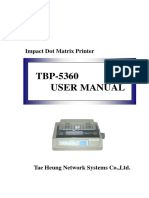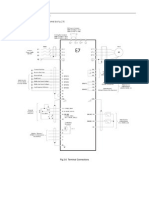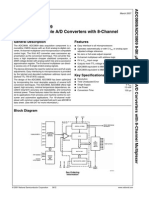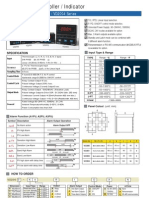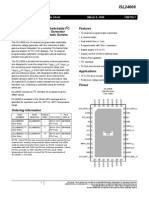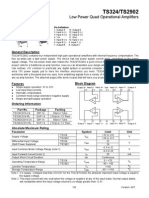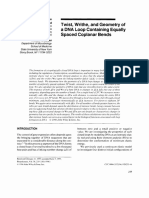Analog Module
Uploaded by
Ngọc Đặng VănAnalog Module
Uploaded by
Ngọc Đặng VănS7-200 Programmable Controller System Manual
Analog Expansion Modules Specifications
Table A-15 Analog Expansion Modules Order Numbers
Expansion Model EM 231 Analog Input, 4 Inputs EM 232 Analog Output, 2 Outputs EM 235 Analog Combination 4 Inputs/1 Outpu t EM Inputs 4 4 EM Outputs 2 11 Removable Connector No No No Order Number 6ES7 231-0HC22-0XA0 6ES7 232-0HB22-0XA0 6ES7 235-0KD22-0XA0
1 The CPU reserves 2 analog output points for this module.
Table A-16
Analog Expansion Modules General Specifications
Module Name and Description EM 231 Analog Input, 4 Inputs EM 232 Analog Output, 2 Outputs EM 235 Analog Combination 4 Inputs/1 Output Dimensions (mm) (W x H x D) 71.2 x 80 x 62 46 x 80 x 62 71.2 x 80 x 62 Weight 183 g 148 g 186 g Dissipation 2W 2W 2W VDC Requirements +5 VDC +24 VDC 20 mA 20 mA 30 mA 60 mA 70 mA (with both outputs at 20 mA) 60 mA (with output at 20 mA)
Order Number 6ES7 231-0HC22-0XA0 6ES7 232-0HB22-0XA0 6ES7 235-0KD22-0XA0
Table A-17
Analog Expansion Modules Input Specifications
General 6ES7 231-0HC22-0XA0 (See Figure A-14) -32000 to +32000 0 to 32000 10 M voltage input 250 current input - db at 3.1 Khz -3 30 VDC 32 mA 11 bits plus 1 sign bit 12 bits None Differential Selectable, see Table A-20 for available ranges 0 to 20 mA See Table A-20 < 250 s 1.5 ms to 95% 6ES7 235-0KD22-0XA0 (See Figure A-14) -32000 to +32000 0 to 32000 10 M voltage input 250 current input - db at 3.1 Khz -3 30 VDC 32 mA
Data word format Bipolar, full-scale range Unipolar, full-scale range DC Input impedance Input filter attenuation Maximum input voltage Maximum input current Resolution Bipolar Unipolar Isolation (field to logic) Input type Input ranges Voltage Current Input resolution Analog to digital conversion time Analog input step response Common mode rejection Common mode voltage 24 VDC supply voltage range
None Differential Selectable, see Table A-21 for available ranges 0 to 20 mA See Table A-21 < 250 s 1.5 ms to 95%
40 dB, DC to 60 Hz 40 dB, DC to 60 Hz Signal voltage plus common mode voltage Signal voltage plus common mode voltage must be must be 12 V 12 V 20.4 to 28.8 VDC (Class 2, Limited Power, or sensor power from PLC)
400
Technical Specifications
Appendix A
Table A-18
Analog Expansion Modules Output Specifications
General 6ES7 232-0HB22-0XA0 None 10 V 0 to 20 mA 12 bits plus sign bit 11 bits -32000 to +32000 0 to +32000 None 10 V 0 to 20 mA 11 bits plus sign bit 11 bits -32000 to +32000 0 to +32000 6ES7 235-0KD22-0XA0 -
Isolation (field to logic) Signal range Voltage output Current output Resolution, full-scale Voltage Current Data word format Voltage Current Accuracy Worst case, 0p to 55p C Voltage output Current output Typical, 25p C Voltage output Current output Setting time Voltage output Current output Maximum drive Voltage output Current output 24 VDC supply voltage range
2% of full-scale 2% of full-scale 0.5% of full-scale 0.5% of full-scale 100 S 2 mS
2% of full-scale 2% of full-scale 0.5% of full-scale 0.5% of full-scale 100 S 2 mS
5000 minimum 5000 minimum 500 maximum 500 maximum 20.4 to 28.8 VDC (Class 2, Limited Power, or sensor power from PLC)
401
S7-200 Programmable Controller System Manual
EM 231 Analog Input, 4 Inputs (6ES7 231-0HC22-0XA0) Voltage
+-
Current
PS PS 0-20mA
+ -M
L+
+
EM 235 Analog Combination 4 Inputs/1 Output (6ES7 235-0KD22-0XA0) Voltage
+-
Current
L+ 4-20mA
-M
PS PS
Unused
4-20mA
--
Unused
0-20mA
+ --
RA A+ A- RB B+ B- RC C+ C- RD D+ D-
RA A+ A- RB B+ B- RC C+ C- RD D+ D-
250 Ohms (built-in)
M L+ Gain Configuration
M L+
250 Ohms (built-in)
M0 V0 I0 Gain Offset Configuration
24 VDC Power
24 VDC Power EM 232 Analog Output, 2 Outputs (6ES7 232-0HB22-0XA0) -
M0 V0 M L+
I0
M1 V1 I1
24 VDC Power
Figure A-12
Wiring Diagrams for Analog Expansion Modules
402
Technical Specifications
Appendix A
Analog LED Indicators
The LED indicators for the analog modules are shown in Table A-19.
Table A-19 Analog LED Indicators
ON No faults No 24 VDC power OFF
LED Indicator 24 VDC Power Supply Good
Tip The state of user power is also reported in Special Memory (SM) bits. For more information, see Appendix D, SMB8 to SMB21 I/O Module ID and Error Registers.
Input Calibration
The calibration adjustments affect the instrumentation amplifier stage that follows the analog multiplexer (see the Input Block Diagram for the EM 231 in Figure A-15 and EM 235 in Figure A-16). Therefore, calibration affects all user input channels. Even after calibration, variations in the component values of each input circuit preceding the analog multiplexer will cause slight differences in the readings between channels connected to the same input signal. To meet the specifications, you should enable analog input filters for all inputs of the module. Select 64 or more samples to calculate the average value. To calibrate the input, use the following steps. 1. 2. 3. 4. 5. 6. 7. 8. Turn off the power to the module. Select the desired input range. Turn on the power to the CPU and module. Allow the module to stabilize for 15 minutes. Using a transmitter, a voltage source, or a current source, apply a zero value signal to one of the input terminals. Read the value reported to the CPU by the appropriate input channel. Adjust the OFFSET potentiometer until the reading is zero, or the desired digital data value. Connect a full-scale value signal to one of the input terminals. Read the value reported to the CPU. Adjust the GAIN potentiometer until the reading is 32000, or the desired digital data value. Repeat OFFSET and GAIN calibration as required.
Calibration and Configuration Location for EM 231 and EM 235
Figure A-13 shows the calibration potentiometer and configuration DIP switches located on the right of the bottom terminal block of the module.
403
S7-200 Programmable Controller System Manual
EM 231
EM 235
On Off
On Off
Fixed Terminal Block Figure A-13
Gain
Configuration
Fixed Terminal Block
Gain Offset
Configuration
Calibration Potentiometer and Configuration DIP Switch Location for the EM 231 and EM 235
Configuration for EM 231
Table A-20 shows how to configure the EM 231 module using the configuration DIP switches. Switches 1, 2, and 3 select the analog input range. All inputs are set to the same analog input range. In this table, ON is closed, and OFF is open. The switch settings are read only when the power is turned on.
Table A-20
SW1 ON
EM 231 Configuration Switch Table to Select Analog Input Range
Unipolar SW2 OFF ON Bipolar SW3 ON OFF FullFull Scale Input 0 to 10 V 0 to 5 V 0 to 20 mA FullFull Scale Input 5V 2.5 V Resolution 2.5 mV 1.25 mV 5 A Resolution 2.5 mV 1.25 mV
SW1 OFF
SW2 OFF ON
SW3 ON OFF
404
Technical Specifications
Appendix A
Configuration for EM 235
Table A-21 shows how to configure the EM 235 module using the configuration DIP switches. Switches 1 through 6 select the analog input range and resolution. All inputs are set to the same analog input range and format. Table A-21 shows how to select for unipolar/bipolar (switch 6), gain (switches 4 and 5), and attenuation (switches 1, 2, and 3). In these tables, ON is closed, and OFF is open. The switch settings are read only when the power is turned on.
Table A-21
SW1 ON OFF ON OFF ON ON OFF SW1 ON OFF OFF ON OFF OFF ON OFF OFF
EM 235 Configuration Switch Table to Select Analog Range and Resolution
Unipolar SW2 OFF ON OFF ON OFF OFF ON SW2 OFF ON OFF OFF ON OFF OFF ON OFF SW3 OFF OFF OFF OFF OFF OFF OFF Bipolar SW3 OFF OFF ON OFF OFF ON OFF OFF ON SW4 ON ON ON OFF OFF OFF OFF OFF OFF SW5 OFF OFF OFF ON ON ON OFF OFF OFF SW6 OFF OFF OFF OFF OFF OFF OFF OFF OFF SW4 ON ON OFF OFF OFF OFF OFF SW5 OFF OFF ON ON OFF OFF OFF SW6 ON ON ON ON ON ON ON FullFull Scale Input 0 to 50 mV 0 to 100 mV 0 to 500 mV 0 to 1 V 0 to 5 V 0 to 20 mA 0 to 10 V FullFull Scale Input +25 mV +50 mV +100 mV +250 mV +500 mV +1 V +2.5 V +5 V +10 V Resolution 12.5 "V 25 "V 125 "V 250 "V 1.25 mV 5 "A 2.5 mV Resolution 12.5 "V 25 "V 50 "V 125 "V 250 "V 500 "V 1.25 mV 2.5 mV 5 mV
405
S7-200 Programmable Controller System Manual
Input Data Word Format for EM 231 and EM 235
Figure A-14 shows where the 12-bit data value is placed within the analog input word of the CPU.
MSB 15 14 AIW XX 0 Data value 12 Bits Unipolar data MSB 15 AIW XX Data value 12 Bits Bipolar data Figure A-14 Input Data Word Format for EM 231 and EM 235 4
2 0 0
LSB 0 0
3 0 0 0
LSB 0 0
Tip The 12 bits of the analog-to-digital converter (ADC) readings are left-justified in the data word format. The MSB is the sign bit: zero indicates a positive data word value. In the unipolar format, the three trailing zeros cause the data word to change by a count of eight for each one-count change in the ADC value. In the bipolar format, the four trailing zeros cause the data word to change by a count of sixteen for each one count change in the ADC value.
Input Block Diagram for EM 231 and EM 235
A+ RA Rloop A-R B+ RB Rloop B-R C+ RC Rloop CR D+ RD Rloop DR Input filter R C C C A=4 MUX 4 to 1 R C C C A=3 R C C C -A=2 11 0 A/D Converter R C C C GAIN ADJUST + Instrumentation AMP
EM 231
A=1
BUFFER
Figure A-15
Input Block Diagram for the EM 231
406
Technical Specifications
Appendix A
A+ RA Rloop A-R B+ RB Rloop B-R C+ RC Rloop CR D+ RD Rloop DR Input filter R C C C A=4 MUX 4 to 1 R C C C A=3 Offset Adjust -REF_VOLT + R C C C A=2 R C C C A=1 +
EM 235
GAIN ADJUST
Instrumentation AMP --
BUFFER A/D Converter 11 0 DATA
Buffer
Figure A-16
Input Block Diagram for the EM 235
Output Data Word Format for EM 232 and EM 235
Figure A-17 shows where the 12-bit data value is placed within the analog output word of the CPU.
MSB 15 14 AQW XX 0 MSB 15 AQW XX
Data value 11 Bits Current output data format Data value 12 Bits Voltage output data format
4 3 0 4 3 0
LSB 0 0 0 LSB 0 0 0
Figure A-17
Output Data Word Format for EM 232 and EM 235
Tip The 12 bits of the digital-to-analog converter (DAC) readings are left-justified in the output data word format. The MSB is the sign bit: zero indicates a positive data word value. The four trailing zeros are truncated before being loaded into the DAC registers. These bits have no effect on the output signal value.
407
S7-200 Programmable Controller System Manual
Output Block Diagram for EM 232 and EM 235
+24 Volt R 100
-+ + -Voltage-to-current converter R Iout 0..20 mA
Vref D/A converter +/-- 2V DATA 11 0 Digital-to-analog converter
+ -R Vout --10.. +10 Volts
1/4
R M
Voltage output buffer
Figure A-18
Output Block Diagram for the EM 232 and EM 235
Installation Guidelines
Use the following guidelines to ensure accuracy and repeatability:
! ! ! ! ! ! ! ! !
Ensure that the 24-VDC Sensor Supply is free of noise and is stable. Use the shortest possible sensor wires. Use shielded twisted pair wiring for sensor wires. Terminate the shield at the Sensor location only. Short the inputs for any unused channels, as shown in Figure A-18. Avoid bending the wires into sharp angles. Use wireways for wire routing. Avoid placing signal wires parallel to high-energy wires. If the two wires must meet, cross them at right angles. Ensure that the input signals are within the common mode voltage specification by isolating the input signals or referencing them to the external 24V common of the analog module.
Tip The EM 231 and EM 235 expansion modules are not recommended for use with thermocouples.
408
Technical Specifications
Appendix A
Understanding the Analog Input Module: Accuracy and Repeatability
The EM 231 and EM 235 analog input modules are low-cost, high-speed 12 bit analog input modules. The modules can convert an analog signal input to its corresponding digital value in 149 sec. The analog signal input is converted each time your program accesses the analog point. These conversion times must be added to the basic execution time of the instruction used to access the analog input. The EM 231 and EM 235 provide an unprocessed digital value (no linearization or filtering) that corresponds to the analog voltage or current presented at the module input terminals. Since the modules are s high-speed modules, they can follow rapid changes in the analog input signal (including internal and external noise).
Average Value Signal Input Mean (average) Accuracy
You can minimize reading-to-reading variations caused by noise for a constant or slowly changing analog input Repeatability limits signal by averaging a number of readings. Note that (99% of all readings fall within these limits) increasing the number of readings used in computing the average value results in a correspondingly slower Figure A-19 Accuracy Definitions response time to changes in the input signal. Figure A-19 shows the 99% repeatability limits, the mean or average value of the individual readings, and the mean accuracy in a graphical form. The specifications for repeatability describe the reading-to-reading variations of the module for an input signal that is not changing. The repeatability specification defines the limits within which 99% of the readings will fall. The repeatability is described in this figure by the bell curve. The mean accuracy specification describes the average value of the error (the difference between the average value of individual readings and the exact value of the actual analog input signal). Table A-22 gives the repeatability specifications and the mean accuracy as they relate to each of the configurable ranges.
409
S7-200 Programmable Controller System Manual
Definitions of the Analog Specifications
! !
Accuracy: deviation from the expected value on a given point Resolution: the effect of an LSB change reflected on the output.
EM 231 and EM 235 Specifications
Repeatability1 % of Full Scale Counts EM 231 Specifications 0 to 5 V 0 to 20 mA 0 to 10 V 2.5 V 5V 0 to 50 mV 0 to 100 mV 0 to 500 mV 0 to 1 V 0 to 5 V 0 to 20 mA 0 to 10 V 25 mV 50 mV 100 mV 250 mV 500 mV 1V 2.5 V 5V 10 V 0.075% 48 0.05% 0 05% 32 0.25% 0.2% 0.1% 160 128 64 0 0 5% 0.075% 24 0 05% 0.05% 16 6 48 EM 235 Specifications 0.25% 0.2% 80 64 0.05% 0 05% 0.075% 24 0.1% 32 Mean (average) Accuracy1,2,3,4 % of Full Scale Counts
Table A-22
Full Scale Input Range
1 2 3 4
Measurements made after the selected input range has been calibrated. The offset error in the signal near zero analog input is not corrected, and is not included in the accuracy specifications. There is a channel-to-channel carryover conversion error, due to the finite settling time of the analog multiplexer. The maximum carryover error is 0.1% of the difference between channels. Mean accuracy includes effects of non-linearity and drift from 0 to 55 degrees C.
410
Technical Specifications
Appendix A
Thermocouple and RTD Expansion Modules Specifications
Table A-23 Thermocouple and RTD Modules Order Numbers
Expansion Model EM 231 Analog Input Thermocouple, 4 Inputs EM 231 Analog Input RTD, 2 Inputs EM Inputs 4 Thermocouple 2 RTD EM Outputs No No Removable Connector Order Number 6ES7 231-7PD22-0XA0 6ES7 231-7PB22-0XA0
Table A-24
Thermocouple and RTD Modules General Specifications
Module Name and Description EM 231 Analog Input Thermocouple, 4 Inputs EM 231 Analog Input RTD, 2 Inputs Dimensions (mm) (W x H x D) 71.2 x 80 x 62 71.2 x 80 x 62 Weight 210 g 210 g Dissipation 1.8 W 1.8 W VDC Requirements +5 VDC +24 VDC 87mA 87 mA 60 mA 60 mA
Order Number 6ES7 231-7PD22-0XA0 6ES7 231-7PB22-0XA0
Table A-25
Thermocouple and RTD Modules Specifications
General 6ES7 231-7PD22-0XA0 Thermocouple 500 VAC 500 VAC 500 VAC 120 VAC > 120 dB at 120 VAC Floating TC TC types (select one per module) S, T, R, E, N, K, J Voltage range : +/- 80 mV 500 VAC 500 VAC 500 VAC 0 > 120 dB at 120 VAC Module ground referenced RTD RTD types (select one per module): platinum (Pt), copper (Cu), nickel (Ni), or Resistance See Table A-30 for available RTD types. 0.1p C / 0.1p F 15 bits plus sign Sigma-delta 405 ms (700 ms for Pt10000) 100 meters to sensor max 20 , 2.7 for Cu max. 85 dB at 50 Hz/60 Hz/400 Hz Resistance: 0 to +27648 1m W 1M 30 VDC - db at 21 kHz -3 0.1% FS (voltage) 0.05% FS 1.5 p C 20.4 to 28.8 VDC 10 M 30 VDC (sense), 5 VDC (source) - db at 3.6 kHz -3 0.1% FS (resistance) 0.05% FS 20.4 to 28.8 VDC 6ES7 231-7PB22-0XA0 RTD
Isolation Field to logic Field to 24 VDC 24 VDC to logic Common mode input range (input channel to input channel) Common mode rejection Input type Input ranges 1
Input resolution Temperature Voltage Resistance Measuring Principle Module update time: All channels Wire length Wire loop resistance Suppression of interference Data word format Maximum sensor dissipation Input impedance Maximum input voltage Input filter attenuation Basic error Repeatability Cold junction error 24 VDC supply voltage range
1
0.1p C / 0.1 p F 15 bits plus sign Sigma-delta 405 ms 100 meters to sensor max. 100 max. 85 dB at 50 Hz/60 Hz/ 400 Hz Voltage: - 27648 to + 27648 -
The input range selection (temperature, voltage on resistance) applies to all channels on the module.
411
S7-200 Programmable Controller System Manual
EM 231 Analog Input Thermocouple, 4 Inputs (6ES7 231-7PD22-0XA0) -
EM 231 Analog Input RTD, 2 Inputs (6ES7 231-7PB22-0XA0) -
+ --
+ --
+ --
+ --
A+ A - B+ B- C+ C- D+ DEM 231 AI 4
A+ A - a+ a- B+ B- b+ bEM 231 AI 2 x RTD
L+
Configuration
L+
Configuration
24 VDC power
24 VDC power
Figure A-20
Connector Terminal Identification for EM 231 Thermocouple and EM 231 RTD Modules
Compatibility
The RTD and Thermocouple modules are designed to work with the CPU 222, CPU 224, CPU 224XP and CPU 226.
Tip The RTD and Thermocouple modules are designed to give maximum performance when installed in a stable temperature environment. The EM 231 Thermocouple module, for example, has special cold junction compensation circuitry that measures the temperature at the module connectors and makes necessary changes to the measurement to compensate for temperature differences between the reference temperature and the temperature at the module. If the ambient temperature is changing rapidly in the area where the EM 231 Thermocouple module is installed, additional errors are introduced. To achieve maximum accuracy and repeatability, Siemens recommends that the S7-200 RTD and Thermocouple modules be mounted in locations that have stable ambient temperature.
Noise Immunity
Use shielded wires for best noise immunity. If a thermocouple input channel is not used, short the unused channel inputs, or connect them in parallel to another channel.
412
You might also like
- Hourglass Workout Program by Luisagiuliet 276% (21)Hourglass Workout Program by Luisagiuliet 251 pages
- The Hold Me Tight Workbook - Dr. Sue Johnson100% (16)The Hold Me Tight Workbook - Dr. Sue Johnson187 pages
- Read People Like A Book by Patrick King-Edited62% (66)Read People Like A Book by Patrick King-Edited12 pages
- Livingood, Blake - Livingood Daily Your 21-Day Guide To Experience Real Health77% (13)Livingood, Blake - Livingood Daily Your 21-Day Guide To Experience Real Health260 pages
- COSMIC CONSCIOUSNESS OF HUMANITY - PROBLEMS OF NEW COSMOGONY (V.P.Kaznacheev,. Л. V. Trofimov.)94% (212)COSMIC CONSCIOUSNESS OF HUMANITY - PROBLEMS OF NEW COSMOGONY (V.P.Kaznacheev,. Л. V. Trofimov.)212 pages
- Donald Trump & Jeffrey Epstein Rape Lawsuit and Affidavits83% (1016)Donald Trump & Jeffrey Epstein Rape Lawsuit and Affidavits13 pages
- The 36 Questions That Lead To Love - The New York Times94% (34)The 36 Questions That Lead To Love - The New York Times3 pages
- The 36 Questions That Lead To Love - The New York Times95% (21)The 36 Questions That Lead To Love - The New York Times3 pages
- Jeffrey Epstein39s Little Black Book Unredacted PDF75% (12)Jeffrey Epstein39s Little Black Book Unredacted PDF95 pages
- The 4 Hour Workweek, Expanded and Updated by Timothy Ferriss - Excerpt23% (954)The 4 Hour Workweek, Expanded and Updated by Timothy Ferriss - Excerpt38 pages
- SAP ABAP - Quick Guide - TutorialspointNo ratings yetSAP ABAP - Quick Guide - Tutorialspoint126 pages
- Terminal Connections: Connections To Drive Terminals Are Shown in Fig 2.8100% (1)Terminal Connections: Connections To Drive Terminals Are Shown in Fig 2.84 pages
- Analog Servo Drive: Description Power RangeNo ratings yetAnalog Servo Drive: Description Power Range7 pages
- Complete 8-Bit A-to-D Converter AD570 : Ms 8C To +708C: AD570J 8C To +1258C: AD570SNo ratings yetComplete 8-Bit A-to-D Converter AD570 : Ms 8C To +708C: AD570J 8C To +1258C: AD570S8 pages
- Analog Servo Drive: Description Power RangeNo ratings yetAnalog Servo Drive: Description Power Range9 pages
- LM2586 Simple Switcher 3A Flyback Regulator With Shutdown: General Description FeaturesNo ratings yetLM2586 Simple Switcher 3A Flyback Regulator With Shutdown: General Description Features29 pages
- μP Compatible A/D Converters with 8-Channel: ADC0808/ADC0809 8-Bit MultiplexerNo ratings yetμP Compatible A/D Converters with 8-Channel: ADC0808/ADC0809 8-Bit Multiplexer16 pages
- Analog Servo Drive: Description Power RangeNo ratings yetAnalog Servo Drive: Description Power Range7 pages
- LM1575/LM1575HV/LM2575/LM2575HV Series Simple Switcher 1A Step-Down Voltage RegulatorNo ratings yetLM1575/LM1575HV/LM2575/LM2575HV Series Simple Switcher 1A Step-Down Voltage Regulator23 pages
- μP Compatible A/D Converters with 8-Channel: ADC0808/ADC0809 8-Bit MultiplexerNo ratings yetμP Compatible A/D Converters with 8-Channel: ADC0808/ADC0809 8-Bit Multiplexer16 pages
- LS7183 / LS7184: Encoder To Counter Interface ChipsNo ratings yetLS7183 / LS7184: Encoder To Counter Interface Chips3 pages
- Analog Servo Drive: Description Power RangeNo ratings yetAnalog Servo Drive: Description Power Range9 pages
- +/-10v Isolated Analog Input Module: Product Specifications and Installation DataNo ratings yet+/-10v Isolated Analog Input Module: Product Specifications and Installation Data4 pages
- Analog Servo Drive: Description Power RangeNo ratings yetAnalog Servo Drive: Description Power Range9 pages
- Analog Servo Drive: Description Power RangeNo ratings yetAnalog Servo Drive: Description Power Range13 pages
- Description Power Range: Analog Servo DriveNo ratings yetDescription Power Range: Analog Servo Drive7 pages
- 14-Channel Programmable Switchable I C TFT-LCD Reference Voltage Generator With Integrated 4-Channel Static Gamma Drivers FeaturesNo ratings yet14-Channel Programmable Switchable I C TFT-LCD Reference Voltage Generator With Integrated 4-Channel Static Gamma Drivers Features10 pages
- Analog Servo Drive: Description Power RangeNo ratings yetAnalog Servo Drive: Description Power Range8 pages
- TS324/TS2902: Low Power Quad Operational AmplifiersNo ratings yetTS324/TS2902: Low Power Quad Operational Amplifiers8 pages
- Analog Servo Drive: Description Power RangeNo ratings yetAnalog Servo Drive: Description Power Range9 pages
- Analog Servo Drive: Description Power RangeNo ratings yetAnalog Servo Drive: Description Power Range9 pages
- ADC0831/ADC0832/ADC0834 and ADC0838 8-Bit Serial I/O A/D Converters With Multiplexer OptionsNo ratings yetADC0831/ADC0832/ADC0834 and ADC0838 8-Bit Serial I/O A/D Converters With Multiplexer Options33 pages
- Reference Guide To Useful Electronic Circuits And Circuit Design Techniques - Part 1From EverandReference Guide To Useful Electronic Circuits And Circuit Design Techniques - Part 12.5/5 (3)
- Reference Guide To Useful Electronic Circuits And Circuit Design Techniques - Part 2From EverandReference Guide To Useful Electronic Circuits And Circuit Design Techniques - Part 2No ratings yet
- Design of Electrical Circuits using Engineering Software ToolsFrom EverandDesign of Electrical Circuits using Engineering Software ToolsNo ratings yet
- Power Systems-On-Chip: Practical Aspects of DesignFrom EverandPower Systems-On-Chip: Practical Aspects of DesignBruno AllardNo ratings yet
- Productivity+™ Active Editor Pro Probe Software For Machine ToolsNo ratings yetProductivity+™ Active Editor Pro Probe Software For Machine Tools10 pages
- Basics of Spar Analysis (Tension Field Beams)No ratings yetBasics of Spar Analysis (Tension Field Beams)39 pages
- Twist, Writhe, and Geometry A Loop Containing Equally Spaced Coplanar BendsNo ratings yetTwist, Writhe, and Geometry A Loop Containing Equally Spaced Coplanar Bends16 pages
- DuctWatch IR Gas Detector Instruction ManualNo ratings yetDuctWatch IR Gas Detector Instruction Manual32 pages
- Part and Assembly Modeling: With Solidworks 2014100% (1)Part and Assembly Modeling: With Solidworks 2014123 pages
- Modelingand Simulationfor One Legof Quadruped Robot TrajectoryNo ratings yetModelingand Simulationfor One Legof Quadruped Robot Trajectory8 pages
- Third Semester B.E. (CBCS) Examination Engineering Mathematics-IIINo ratings yetThird Semester B.E. (CBCS) Examination Engineering Mathematics-III3 pages
- Dynamic Memory Allocation in C Using MallocNo ratings yetDynamic Memory Allocation in C Using Malloc3 pages
- Quality Control of Products in Petroleum RefiningNo ratings yetQuality Control of Products in Petroleum Refining29 pages
- Bulb Units The Complete Solution For Low Heads: Power100% (1)Bulb Units The Complete Solution For Low Heads: Power12 pages
- Livingood, Blake - Livingood Daily Your 21-Day Guide To Experience Real HealthLivingood, Blake - Livingood Daily Your 21-Day Guide To Experience Real Health
- COSMIC CONSCIOUSNESS OF HUMANITY - PROBLEMS OF NEW COSMOGONY (V.P.Kaznacheev,. Л. V. Trofimov.)COSMIC CONSCIOUSNESS OF HUMANITY - PROBLEMS OF NEW COSMOGONY (V.P.Kaznacheev,. Л. V. Trofimov.)
- Donald Trump & Jeffrey Epstein Rape Lawsuit and AffidavitsDonald Trump & Jeffrey Epstein Rape Lawsuit and Affidavits
- The 36 Questions That Lead To Love - The New York TimesThe 36 Questions That Lead To Love - The New York Times
- The 36 Questions That Lead To Love - The New York TimesThe 36 Questions That Lead To Love - The New York Times
- Jeffrey Epstein39s Little Black Book Unredacted PDFJeffrey Epstein39s Little Black Book Unredacted PDF
- The 4 Hour Workweek, Expanded and Updated by Timothy Ferriss - ExcerptThe 4 Hour Workweek, Expanded and Updated by Timothy Ferriss - Excerpt
- Terminal Connections: Connections To Drive Terminals Are Shown in Fig 2.8Terminal Connections: Connections To Drive Terminals Are Shown in Fig 2.8
- Complete 8-Bit A-to-D Converter AD570 : Ms 8C To +708C: AD570J 8C To +1258C: AD570SComplete 8-Bit A-to-D Converter AD570 : Ms 8C To +708C: AD570J 8C To +1258C: AD570S
- LM2586 Simple Switcher 3A Flyback Regulator With Shutdown: General Description FeaturesLM2586 Simple Switcher 3A Flyback Regulator With Shutdown: General Description Features
- μP Compatible A/D Converters with 8-Channel: ADC0808/ADC0809 8-Bit MultiplexerμP Compatible A/D Converters with 8-Channel: ADC0808/ADC0809 8-Bit Multiplexer
- LM1575/LM1575HV/LM2575/LM2575HV Series Simple Switcher 1A Step-Down Voltage RegulatorLM1575/LM1575HV/LM2575/LM2575HV Series Simple Switcher 1A Step-Down Voltage Regulator
- μP Compatible A/D Converters with 8-Channel: ADC0808/ADC0809 8-Bit MultiplexerμP Compatible A/D Converters with 8-Channel: ADC0808/ADC0809 8-Bit Multiplexer
- LS7183 / LS7184: Encoder To Counter Interface ChipsLS7183 / LS7184: Encoder To Counter Interface Chips
- +/-10v Isolated Analog Input Module: Product Specifications and Installation Data+/-10v Isolated Analog Input Module: Product Specifications and Installation Data
- 14-Channel Programmable Switchable I C TFT-LCD Reference Voltage Generator With Integrated 4-Channel Static Gamma Drivers Features14-Channel Programmable Switchable I C TFT-LCD Reference Voltage Generator With Integrated 4-Channel Static Gamma Drivers Features
- TS324/TS2902: Low Power Quad Operational AmplifiersTS324/TS2902: Low Power Quad Operational Amplifiers
- ADC0831/ADC0832/ADC0834 and ADC0838 8-Bit Serial I/O A/D Converters With Multiplexer OptionsADC0831/ADC0832/ADC0834 and ADC0838 8-Bit Serial I/O A/D Converters With Multiplexer Options
- Reference Guide To Useful Electronic Circuits And Circuit Design Techniques - Part 1From EverandReference Guide To Useful Electronic Circuits And Circuit Design Techniques - Part 1
- Reference Guide To Useful Electronic Circuits And Circuit Design Techniques - Part 2From EverandReference Guide To Useful Electronic Circuits And Circuit Design Techniques - Part 2
- Solar Inverter Design with Improved PerformanceFrom EverandSolar Inverter Design with Improved Performance
- Variable Speed AC Drives with Inverter Output FiltersFrom EverandVariable Speed AC Drives with Inverter Output Filters
- Analog Dialogue, Volume 48, Number 1: Analog Dialogue, #13From EverandAnalog Dialogue, Volume 48, Number 1: Analog Dialogue, #13
- Design of Electrical Circuits using Engineering Software ToolsFrom EverandDesign of Electrical Circuits using Engineering Software Tools
- Power Systems-On-Chip: Practical Aspects of DesignFrom EverandPower Systems-On-Chip: Practical Aspects of Design
- Productivity+™ Active Editor Pro Probe Software For Machine ToolsProductivity+™ Active Editor Pro Probe Software For Machine Tools
- Twist, Writhe, and Geometry A Loop Containing Equally Spaced Coplanar BendsTwist, Writhe, and Geometry A Loop Containing Equally Spaced Coplanar Bends
- Modelingand Simulationfor One Legof Quadruped Robot TrajectoryModelingand Simulationfor One Legof Quadruped Robot Trajectory
- Third Semester B.E. (CBCS) Examination Engineering Mathematics-IIIThird Semester B.E. (CBCS) Examination Engineering Mathematics-III
- Bulb Units The Complete Solution For Low Heads: PowerBulb Units The Complete Solution For Low Heads: Power




































